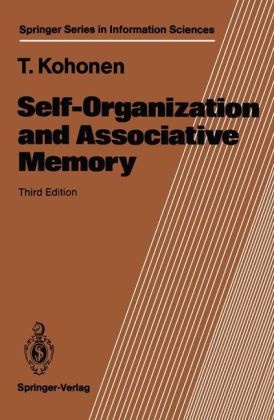Share
Fr. 69.00
Teuvo Kohonen
Self-Organization and Associative Memory
English · Paperback / Softback
Shipping usually within 1 to 2 weeks (title will be printed to order)
Description
This monograph gives a tutorial treatment of new approaches to self-organization, adaptation, learning and memory. It is based on recent research results, both mathematical and computer simulations, and lends itself to graduate and postgraduate courses in the natural sciences. The book presents new formalisms of pattern processing: orthogonal projectors, optimal associative mappings, novelty filters, subspace methods, feature-sensitive units, and self-organization of topological maps, with all their computable algorithms. The main objective is to provide an understanding of the properties of information representations from a general point of view and of their use in pattern information processing, as well as an understanding of many functions of the brain. In the third edition two new discussions have been added and a proof has been revised. The author has developed this book from Associative Memory - A System-Theoretical Approach (Volume 17 of Springer Series in Communication and Cybernetics, 1977), the first ever monograph on distributed associative memories.
List of contents
1. Various Aspects of Memory.- 1.1 On the Purpose and Nature of Biological Memory.- 1.1.1 Some Fundamental Concepts.- 1.1.2 The Classical Laws of Association.- 1.1.3 On Different Levels of Modelling.- 1.2 Questions Concerning the Fundamental Mechanisms of Memory.- 1.2.1 Where Do the Signals Relating to Memory Act Upon?.- 1.2.2 What Kind of Encoding is Used for Neural Signals?.- 1.2.3 What are the Variable Memory Elements?.- 1.2.4 How are Neural Signals Addressed in Memory?.- 1.3 Elementary Operations Implemented by Associative Memory.- 1.3.1 Associative Recall.- 1.3.2 Production of Sequences from the Associative Memory.- 1.3.3 On the Meaning of Background and Context.- 1.4 More Abstract Aspects of Memory.- 1.4.1 The Problem of Infinite-State Memory.- 1.4.2 Invariant Representations.- 1.4.3 Symbolic Representations.- 1.4.4 Virtual Images.- 1.4.5 The Logic of Stored Knowledge.- 2. Pattern Mathematics.- 2.1 Mathematical Notations and Methods.- 2.1.1 Vector Space Concepts.- 2.1.2 Matrix Notations.- 2.1.3 Further Properties of Matrices.- 2.1.4 Matrix Equations.- 2.1.5 Projection Operators.- 2.1.6 On Matrix Differential Calculus.- 2.2 Distance Measures for Patterns.- 2.2.1 Measures of Similarity and Distance in Vector Spaces.- 2.2.2 Measures of Similarity and Distance Between Symbol Strings.- 2.2.3 More Accurate Distance Measures for Text.- 3. Classical Learning Systems.- 3.1 The Adaptive Linear Element (Adaline).- 3.1.1 Description of Adaptation by the Stochastic Approximation.- 3.2 The Perceptron.- 3.3 The Learning Matrix.- 3.4 Physical Realization of Adaptive Weights.- 3.4.1 Perceptron and Adaline.- 3.4.2 Classical Conditioning.- 3.4.3 Conjunction Learning Switches.- 3.4.4 Digital Representation of Adaptive Circuits.- 3.4.5 Biological Components.- 4. A New Approach to Adaptive Filters.- 4.1 Survey of Some Necessary Functions.- 4.2 On the Transfer Function of the Neuron.- 4.3 Models for Basic Adaptive Units.- 4.3.1 On the Linearization of the Basic Unit.- 4.3.2 Various Cases of Adaptation Laws.- 4.3.3 Two Limit Theorems.- 4.3.4 The Novelty Detector.- 4.4 Adaptive Feedback Networks.- 4.4.1 The Autocorrelation Matrix Memory.- 4.4.2 The Novelty Filter.- 5. Self-Organizing Feature Maps.- 5.1 On the Feature Maps of the Brain.- 5.2 Formation of Localized Responses by Lateral Feedback.- 5.3 Computational Simplification of the Process.- 5.3.1 Definition of the Topology-Preserving Mapping.- 5.3.2 A Simple Two-Dimensional Self-Organizing System.- 5.4 Demonstrations of Simple Topology-Preserving Mappings.- 5.4.1 Images of Various Distributions of Input Vectors.- 5.4.2 The Magic TV .- 5.4.3 Mapping by a Feeler Mechanism.- 5.5 Tonotopic Map.- 5.6 Formation of Hierarchical Representations.- 5.6.1 Taxonomy Example.- 5.6.2 Phoneme Map.- 5.7 Mathematical Treatment of Self-Organization.- 5.7.1 Ordering of Weights.- 5.7.2 Convergence Phase.- 5.8 Automatic Selection of Feature Dimensions.- 6. Optimal Associative Mappings.- 6.1 Transfer Function of an Associative Network.- 6.2 Autoassociative Recall as an Orthogonal Projection.- 6.2.1 Orthogonal Projections.- 6.2.2 Error-Correcting Properties of Projections.- 6.3 The Novelty Filter.- 6.3.1 Two Examples of Novelty Filter.- 6.3.2 Novelty Filter as an Autoassociative Memory.- 6.4 Autoassociative Encoding.- 6.4.1 An Example of Autoassociative Encoding.- 6.5 Optimal Associative Mappings.- 6.5.1 The Optimal Linear Associative Mapping.- 6.5.2 Optimal Nonlinear Associative Mappings.- 6.6 Relationship Between Associative Mapping, Linear Regression, and Linear Estimation.- 6.6.1 Relationship of the Associative Mapping to Linear Regression.- 6.6.2 Relationship of the Regression Solution to the Linear Estimator.- 6.7 Recursive Computation of the Optimal Associative Mapping.- 6.7.1 Linear Corrective Algorithms.- 6.7.2 Best Exact Solution (Gradient Projection).- 6.7.3 Best Approximate Solution (Regression).- 6.7.4 Recursive Solution in the General Case.- 6.8 Special Cases.- 6.8.1 The Correlation Matrix Memory.- 6.
Product details
| Authors | Teuvo Kohonen |
| Publisher | Springer, Berlin |
| Languages | English |
| Product format | Paperback / Softback |
| Released | 01.01.1989 |
| EAN | 9783540513872 |
| ISBN | 978-3-540-51387-2 |
| No. of pages | 312 |
| Weight | 478 g |
| Illustrations | 100 SW-Abb., |
| Series |
Springer Series in Information Sciences Springer Series in Information Sciences |
| Subject |
Natural sciences, medicine, IT, technology
> Medicine
> Clinical medicine
|
Customer reviews
No reviews have been written for this item yet. Write the first review and be helpful to other users when they decide on a purchase.
Write a review
Thumbs up or thumbs down? Write your own review.

